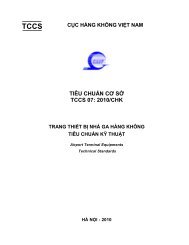AC 18-001 DG Certification CAAV [A]2009E.fm
AC 18-001 DG Certification CAAV [A]2009E.fm
AC 18-001 DG Certification CAAV [A]2009E.fm
Create successful ePaper yourself
Turn your PDF publications into a flip-book with our unique Google optimized e-Paper software.
CIVIL AVIATION AUTHORITYOF VIETNAMADVISORY CIRCULAR<strong>AC</strong> <strong>18</strong>-<strong>001</strong>PROCESS & APPLICATION:TRANSPORTATION OF DANGEROUS GOODS BY AIRSECTION 1GENERAL1.1 PURPOSEThis Advisory Circular (<strong>AC</strong>) provides specific guidance to organizations preparing for andcompletion of the <strong>CAAV</strong> certification process for the transport of dangerous goods by air.1.2 STATUS OF THIS ADVISORY CIRCULARThis is an original issuance of this <strong>AC</strong>.1.3 B<strong>AC</strong>KGROUNDA. ICAO Standards in Annex <strong>18</strong>, Safe Transportation of Dangerous Goods by Air, require thatVietnam must complete an assessment of an individual, organization or entity before issuingan authorization allowing these entities to engage in the process of transportation ofdangerous goods by air.B. In support of its international safety oversight obligations, Vietnam has safety legislation andguidance regarding the requirements that apply to the safe transportation of dangerousgoods, including—1) VAR Part <strong>18</strong>; and2) Dangerous goods advisory circularsC. Vietnam has established a certification process to ensure the completeness andstandardization for the issuance of authorizations to transport dangerous goods by air.1.4 APPLICABILITYThis <strong>AC</strong> is applicable to all operators and organizations involved in the process of transportationof dangerous goods by air in aircraft of Vietnam registry and/or as the holder of an Air Operatoror Aerial Work Certificate.1.5 RELATED REGULATIONSThe following regulations are directly applicable to the guidance contained in this advisorycircular—• Part <strong>18</strong>, Carriage of Dangerous Goods by Air• Advisory Circulars are intended to priovide advice and guidance to illustrate a means, but not necessarily the only means, ofcomplying with the Regulations, or to explain certain regulatory requirements by providing informative, interpretative andexplanatory material.• Where an <strong>AC</strong> is referred to in a ‘Note’ below the regulation, the <strong>AC</strong> remains as guidance material,• <strong>AC</strong>s should always be read in conjunction with the referenced regulations.Issue Date: 31 October 2009
<strong>AC</strong> <strong>18</strong>-<strong>001</strong>: DANGEROUS GOODS CERTIFICATION31.7.2 <strong>AC</strong>RONYMSThe following acronyms are used in this manual—5) AOC – Air Operator Certificate6) COMAT – Company Materials7) <strong>DG</strong> – Dangerous Goods8) <strong>DG</strong>C – Dangerous Goods Coordinator9) <strong>DG</strong>R – IATA Dangerous Goods Regulations10) IAEA – International Atomic Energy Agency.11) IATA – International Air Transport Association12) ICAO – International Civil Aviation Organization13) ICAO-TI’s – International Civil Aviation Organization Technical Instruction for the SafeTransport of Dangerous Goods by Air.14) NOTOC – Notification to the CaptainSECTION 2OPERATIONAL CERTIFICATION2.1 PHASE ONE: PRE-APPLICATION2.1.1 DECLARATION OF INTENTA. The organization or individual intending to transport dangerous goods by air should officiallyadvise the <strong>CAAV</strong> that they intend to apply for authorization to transport dangerous goods byair.B. This is normally accomplished by the submission of a formal letter of intent.2.1.2 PRE-APPLICATION MEETINGA. The operator is entitled to a pre-application meeting to provide more specific guidanceregarding the submission of a complete formal application.B. The operator may, however, choose to submit their application without attending themeeting.2.1.3 PRE-APPLICATION MEETING CONTENTSThis meeting will normally contain a discussion of the—1) Provision of the application in paper copies and digital files.2) Process and actions that will be followed to complete the certification include—(a) Initial application review(b) Document conformance evaluations(c) Inspections and demonstrations; and(d) Final certification actions by <strong>CAAV</strong>3) Formal application checklist;4) Part <strong>18</strong> Conformance Checklist;5) Dangerous Goods Manual;6) Dangerous Goods Training ProgramIssue Date: 31 October 2009
4<strong>AC</strong> <strong>18</strong>-<strong>001</strong>: DANGEROUS GOODS CERTIFICATION7) Revisions to the Flight Operations manual;8) Revision to the Cabin Crew Member manual, if applicable;9) Revision to the Station manual;10) Proposed service providers2.2 PHASE TWO: INITIAL APPLICATION REVIEW2.2.1 HANDLING OF THE FORMAL APPLICATIONA. The submission of the formal application will not be treated by the <strong>CAAV</strong> as formal event.B. The organization may have meeting to present the application, but the <strong>CAAV</strong> will notcomment on the quality of the application at that time.2.2.2 INITIAL APPLICATION REVIEW MEETINGThe <strong>CAAV</strong> will hold an internal meeting at a later day to determine if the contents of theapplication are acceptable for processing. The standard used will be that the application—• Is complete (all required documents); and• Complies with the general requirements for such applications.2.2.3 FORMAL REJECTION OR <strong>AC</strong>CEPTANCEA. Shortly after the <strong>CAAV</strong>’s internal meeting, they will schedule a formal meeting to officially—1) Reject the application, or2) Accept the application package for processing through the document conformancephase.B. If the intial review and meeting are found to be acceptable, the <strong>CAAV</strong> will them accept thedocuments for processing.2.3 PHASE THREE: DOCUMENT CONFORMANCE2.3.1 USE ALL AVAILABLE REFERENCESThe applicant should use the followingThese references will be used by the <strong>CAAV</strong> todocuments during the development of its formalcross-compare with the documentation submittedby the applicant.application submission—1) Part <strong>18</strong> of the VARs;2) <strong>CAAV</strong> Dangerous Goods Advisory Circulars3) ICAO Technical Instructions;4) IATA Dangerous Goods Regulations; and5) Other relevant published international safety practices.2.3.2 CONFORMANCE CHECKLISTA. The most accurate indicator of the completeness of the dangerous goods certification is thePart <strong>18</strong> conformance checklist in its final form.Issue Date: 31 October 2009
<strong>AC</strong> <strong>18</strong>-<strong>001</strong>: DANGEROUS GOODS CERTIFICATION5B. Usually the initial conformance checklistsubmitted by an operator is very inaccuratewith respect to the manual references andcomments regarding the conformance of thecompany manuals to the applicableregulations.C. This checklist will be continually updatedduring this process to reflect the accurate orrevised manual procedures.• This conformance checklist must beaccurate before the certification canbe completed.• The operator should make every effortto have it acceptable at the time ofsubmission of the application.Obtain a template copy of the Part <strong>18</strong> ConformanceChecklist from the <strong>CAAV</strong>.D. The final conformance checklist will be inserted in the Completed <strong>Certification</strong> Report binderas one of the primary “proofs” that, at the time of certification, the applicant was inconformance with the minimum standards of the applicable regulation.2.3.3 ORGANIZATIONA. Evaluation of the applicant’s organization and key personnel associated with the proposeddangerous goods will occur early in this phase.B. If the <strong>CAAV</strong> has any objections or reservations regarding the proposed organization or keypersonnel, these will be shared with the applicant as soon as possible.C. This urgency will also apply to the any service providers proposed for use in the dangerousgoods process. The contractual arrangements with these personnel and the assignedresponsibilities must be understandable to the <strong>CAAV</strong>.2.3.4 MANUALSA. The <strong>CAAV</strong> will evaluation the <strong>DG</strong>Operations Manual through comparisons ofthe proposed information, policy andprocedure with the—1) Submitted conformance checklist;2) ICAO Technical Instructions; andRefer the <strong>CAAV</strong> Advisory Circular <strong>AC</strong> <strong>18</strong>-002 formore specific guidance for this documentation.3) Advisory circulars and other relevant manuals.B. If the applicant has included accurate <strong>DG</strong> legislation references in the text of the manual thiscomparison process can be accelerated.C. The <strong>CAAV</strong> will also evaluate the applicant’s arrangements for ensuring that all personsinvolved in <strong>DG</strong> preparation or acceptance have direct and immediate access to the <strong>DG</strong>reference manuals.2.3.5 TRANSPORT POLICIESA. The applicant must have very specific policies regarding the classes and quantities ofdangerous goods that will be transported or forbidden.• These policies should be evaluated with respect to the ICAO-TI and the applicant’s apparentcapabilitiesB. The applicant should have specific guidance to the flight crews regarding their transport ofarticles that may be considered to be dangerous goods.C. This is also true in passenger handlingsituations, the persons who performticketing, gate and cabin duties must beknowledgeable of articles that may or maynot be carried on board the aircraft.<strong>DG</strong> guidance should be included in the <strong>DG</strong> Operationsmanual and as a chapter in the specificprimary user manuals.Issue Date: 31 October 2009
6<strong>AC</strong> <strong>18</strong>-<strong>001</strong>: DANGEROUS GOODS CERTIFICATION2.3.6 PREPARATION & <strong>AC</strong>CEPTANCEA. The persons involved in the preparation or acceptance of dangerous goods for transport byair are the most critical performers in this process.B. The instructions and guidance that are provided to them must be very complete andaccurate.2.3.7 STORAGE, HANDLING & SEGREGATIONA. The storage, handling and segregation of the dangerous goods will be performed at almostevery juncture in the transport process.B. Depending on the classes, divisions and subsidiary risks of the dangerous goods proposedto be transported, these procedures can be critical. They must adhere closely to the ICAO-TIrequirements.2.3.8 INCIDENT PROCEDURESA. All goods involved in transportation are subject to damage depending on the manner inwhich they are handled.B. Damage and possible leakage in thetransportation of some dangerous goodscan have catastrophic consequences.C. Proper reporting of these incidents is a VARrequirement.2.3.9 LOADING & TRANSPORTA. The actual loading of the aircraft is also a critical point in the transport of dangerous goods byair. The location, segregation and securing of these articles, containers or overpacks mustbe done by knowledgeable persons using good procedures.B. The provision of the information regarding the dangerous goods classes and locations willensure that the flight crews are prepared to make correct decisions if incident occurs in flight.This document is also made available to ground personnel including responders. It is criticalto safety.2.3.10 FORMS & RECORDSA. The applicant will be using forms, records and other documents to ensure conformance withthe applicable requirements.B. These documents must be easy to understand and use.2.3.11 EMERGENCY PROVISIONSA. Emergency procedures that provide clear instructions to the participants in the processcontribute to effective handling of incidents before they become emergencies.B. The emergency procedures will be carefully checked using the reference and aircraft -specific documents.2.3.12 TRAININGA. Dangerous goods training is stressed as the most effective factor in safe transport by air.B. The requirements provided in the ICAO-TIwill provide for a comprehensive trainingprogram.• There must be adequate guidance for handling andcontaining damage and leakage incidents.• The reporting procedures should be sufficient toprovide a good starting point for the investigation.Refer the <strong>CAAV</strong> Advisory Circular <strong>AC</strong> <strong>18</strong>-003 formore specific guidance for this documentation.Issue Date: 31 October 2009
<strong>AC</strong> <strong>18</strong>-<strong>001</strong>: DANGEROUS GOODS CERTIFICATION7C. The submitted training program and curriculums include all required training subjects andexercises will be thoroughly reviewed to meet the training objectives.2.3.13 QUALITY ASSURANCEA. Most applicants do not perform all aspects of the dangerous goods process using companypersonnel.B. This is an area where the set-up of good quality audits by the operator will be vital to thecontinued conformance to the minimum standards for safe transport of dangerous goods.2.4 PHASE FOUR: INSPECTION & DEMONSTRATIONIn practice, the applicant will experience fouridentifiable groupings of inspections in thisphase—1) Training;2) Preparatory;3) Shipments; and4) Operational Demonstration.2.4.1 TRAINING INSPECTIONSA. The participants will need to receive the qualifying training early in the process.B. This may be done in a centralized class or will be done in several non-concurrent locationsdepending on the work functions of the participants.C. The <strong>CAAV</strong> will conduct inspections thetraining as necessary to validate thecompleteness and quality of the trainingrelated to the specific curriculum andobjectives.• This phase will sometimes overlap with thecompletion of the Document Conformance Phasedue to corrections necessary to documents.• This will be especially true if additional documentrevisions result from inspection findings.The <strong>CAAV</strong> will review the training records of allparticipants to ensure documented qualificationbefore conducting the inspections included inthe shipping and operational groupings.D. The performance of the instructors used in the <strong>DG</strong> training must be satisfactory.2.4.2 PREPARATORY INSPECTIONSA. The <strong>CAAV</strong> will conduct inspections at the facilities of the operator and service providers toensure that the necessary infrastructure exists.B. These inspections will include—The <strong>CAAV</strong> will not conduct the shipping and1) Facilities, including signage andoperational inspections until these preparatoryequipment necessary for movement of inspections have been conducted for all identifiedentities.<strong>DG</strong>;2) Correct and sufficient copies of manuals necessary to the <strong>DG</strong> process;3) Adequacy of the supplies necessary to the <strong>DG</strong> process; and4) Adequacy for handling and storage of the classes of <strong>DG</strong> to be shipped.2.4.3 SHIPPING INSPECTIONSThe <strong>CAAV</strong> personnel will be present to monitor the actual—1) Preparation and packaging of the first dangerous goods to be shipped as cargo on therequired validation flight.Issue Date: 31 October 2009
8<strong>AC</strong> <strong>18</strong>-<strong>001</strong>: DANGEROUS GOODS CERTIFICATION2) Acceptance of the dangerous goodspackages by the operator or agent;3) Completion of the shipping papers thataccompany the dangerous goodspackage; and4) Performance of the personnel at these critical steps in the dangerous goods process.2.4.4 CARRY VALIDATION FLIGHT AUTHORIZATIONA. When the previously identified issues are resolved, the <strong>CAAV</strong> will issue a letter authorizingthe operator to conduct a validation first flight carrying dangerous goods under thesupervision of the <strong>CAAV</strong>.B. The applicant must carry a copy of this letter in the aircraft flight deck, located with the draftaircraft display AOC and operations specifications, during the flight.2.4.5 OPERATIONAL INSPECTIONSThe <strong>CAAV</strong> personnel will be present to monitorthe actual—1) Loading (and subsequent unloading) ofthe aircraft;2) Completion of the loading documents related to transport of <strong>DG</strong> by air, including theNOTOC;3) Flight crew procedures relative to the presence of dangerous goods, understanding ofthe NOTOC, possible dangers and emergency procedures.2.4.6 VALIDATION FLIGHT RESULTSIf the results were—The <strong>CAAV</strong> will not authorize a validation flightunless all issues identified in the training, preparatoryand shipping inspections have beenresolved.The applicant should expect that one or more ofthe <strong>CAAV</strong> personnel will be on the validationflight.• Acceptable, the <strong>CAAV</strong> will proceed to the completion of the necessary operational authorizations.• Not acceptable, the <strong>CAAV</strong> will ensure the correction of the issues before authorizing anothervalidation flight.2.5 PHASE FIVE: FINAL CERTIFICATION <strong>AC</strong>TIONS2.5.1 ISSUANCE OF OPERATIONAL APPROVALSA. All documents previously granted interim approval during the certification will now be grantedoperational approval by the <strong>CAAV</strong>.B. At a minimum, these approvals will be given to <strong>DG</strong>—1) Operations manuals and/or supplements to other manuals:2) Training programs and/or curriculums; and3) Documents, such as forms, records.2.5.2 AMENDMENT OF MASTER OPERATIONS SPECIFICATIONSA. Part H of the master operations• 1160D: Issue Revised Ops Specs Pagespecifications will be amended to show theauthorization for transportation ofdangerous goods by air.B. A print-out of that amended operations specifications shall be circulated for VAR andoperator signatures.OPS 4.345Issue Date: 31 October 2009
<strong>AC</strong> <strong>18</strong>-<strong>001</strong>: DANGEROUS GOODS CERTIFICATION92.5.3 AMENDMENT OF AIRCRAFT DISPLAY OPERATIONS SPECIFICATIONSAn amended aircraft display operations specifications shall be issued for each aircraft make,model and series that the operator may use for transport of dangerous goods.SECTION 3CONTENTS OF FORMAL APPLICATION P<strong>AC</strong>KAGE3.1 GENERAL REQUIREMENTSThe following documents will be considered individually—1) Formal Application Checklist;2) Part <strong>18</strong> Conformance Checklist;3) Dangerous Goods Manual(s);4) Dangerous Goods Training Program with applicable curriculums5) Revisions to the Flight Operations manual;6) Revision to the Cabin Crew Member manual, if applicable;7) Revision to the Station manual;8) List of proposed services providers9) Subscription to ICAO Technical Instructions in sufficient quantities for use by personel10) Subscription to ICTA Dangerous Goods Regulations in sufficient quantities for use bypersonnel11) Copies of all forms proposed to be used by company personnel and service providers, ifapplicable.3.2 AVAILABLE FOR CONSULTATIONThe following documents must be available atthe applicant’s facilities for consultation—1) ICAO Technical Instructions;2) IATA Dangerous Goods Regulations• <strong>CAAV</strong> inspectors shall have unobstructed abilityto refer to these documents.• If this criteria is not met, copies of these manualswill be required to be submitted to the <strong>CAAV</strong>offices as a part of the application.End of Advisory CircularIssue Date: 31 October 2009
10<strong>AC</strong> <strong>18</strong>-<strong>001</strong>: DANGEROUS GOODS CERTIFICATIONThis Page Intentionally Left BlankIssue Date: 31 October 2009


![AC 18-001 DG Certification CAAV [A]2009E.fm](https://img.yumpu.com/43214114/1/500x640/ac-18-001-dg-certification-caav-a2009efm.jpg)
![AC 07-014 ATPL-H CAAV [A]2009.fm](https://img.yumpu.com/50745568/1/190x245/ac-07-014-atpl-h-caav-a2009fm.jpg?quality=85)
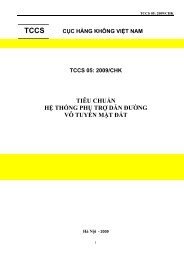
![TBD AC 01-001 Regulation Intro CAAV [A1]2009.fm](https://img.yumpu.com/45108462/1/190x245/tbd-ac-01-001-regulation-intro-caav-a12009fm.jpg?quality=85)
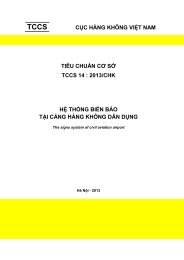
![AC 00-003 Safety Management System [0]2010.fm](https://img.yumpu.com/43642964/1/190x245/ac-00-003-safety-management-system-02010fm.jpg?quality=85)
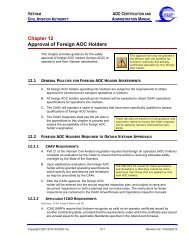


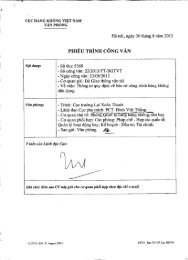
![AC 12-002 Add New Type [A]2010.fm](https://img.yumpu.com/38814666/1/190x245/ac-12-002-add-new-type-a2010fm.jpg?quality=85)
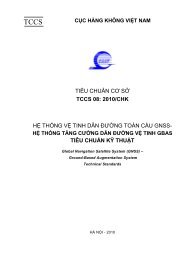

![AC 18-002 DG Manuals CAAV [A]2009.fm](https://img.yumpu.com/38813103/1/190x245/ac-18-002-dg-manuals-caav-a2009fm.jpg?quality=85)
